Human smuggling networks in Pakistan are thriving as the lure of a stable future in Europe drives both rich and poor to gamble their lives on dangerous migration routes.
Last month, around 50 Pakistanis died on a migrant boat, while trying to cross the Atlantic Ocean illegally to reach Europe in what has been called the Atlantic boat tragedy.
The tragedy is not the first one. In June 2023, 300 hundred Pakistanis drowned in a migrant boat disaster. The boat capsized off the coast of Greece, with Italy being the intended destination. Before that, seven Pakistanis died off the coast of Libya in April 2023, in an incident that claimed 57 lives.
Migrant smuggling has grown more frequent and dangerous in the last few years, with the trend impacting both the country’s reputation and the lives of those caught in it. The UK has faced a surge in migrant inflows across the channel, while the USA and Australia have become favoured destinations in recent years.
But why are people choosing to risk their lives for these proverbial greener pastures? And who is benefitting from the human trafficking?
The double threat
There are two parts to the problem. First, the number of migrants attempting the journey is steadily increasing, as seen in the rising figures from source countries. For example, the migrant number in Italy has almost doubled in just one year, from 50,000 to 80,000. A 2023 study by the United Nations Office on Drugs and Crime (UNODC) and the European Union (EU) found that 24,000 Pakistanis entered EU countries illegally over the past three years. Pakistan now ranks fifth among countries sending migrants to Europe, with a particularly alarming 280 per cent surge in 2022 alone.
The entire smuggling operation has a massive financial dimension too. The standard ‘rate’ for landing in Europe is reportedly $11,926 (equivalent to Rs3.3 million). For the 24,000 Pakistanis who made the journey, this translates into the value of enterprise to be Rs80 billion. One must not forget that this fee only covers transportation — smugglers do not guarantee any employment or settlement; they simply take responsibility for the journey itself. With such enormous sums involved, it’s no surprise that more players are being drawn into the smuggling trade.
The other major concern is the growing reliance on perilous sea routes off the North African coast. The same UNODC-EU study found that nearly half of all migrants were smuggled via the eastern and central Mediterranean sea routes.
The year 2024 saw a devastating loss of life in the Mediterranean, with over 2,200 people either dead or missing — nearly 1,700 of them on the central Mediterranean route alone. Pakistan, as per reports, is the fifth largest contributor to these sea-based attempts. One can speculate that the true scale of fatalities of Pakistani migrants is in the hundreds, if not higher.
Pull and push factor framework
Migrant smuggling must be understood within the pull-push framework. Pull factors are the forces that attract people to greener pastures — perceived better opportunities, often in wealthier countries — while push factors are the conditions that drive individuals to flee their home countries. In this context, pull and push factors can also be understood as the demand and supply sides of migrant smuggling. Pull factors drive the demand for smuggling services, while push factors shape the supply, both determining the dynamics of migration.
On the pull side, the stark contrast in earnings between Europe and home countries draws many, alongside the lure of a confirmed path to citizenship, regardless of how one arrives. Lenient human rights policies in European countries further attract migrants, as does the relatively high retention rate —meaning that once people arrive, they’re less likely to face deportation. The success stories of those making it despite the odds fuel further aspirations, while kinship links along the GT Road ensure a sense of security for migrants once they reach their destinations.
On the push side, socio-economic competition in districts along the GT Road exacerbates local tensions, driving many to seek a way out. This is compounded by the growing efficiency of smuggling networks, alongside the emergence of new sea routes such as the eastern and central Mediterranean paths, and new destinations such as Portugal and Romania. The ease of access to transit points in countries like the UAE, Egypt, and Morocco makes these routes all the more appealing. Meanwhile, policy ambiguity in Pakistan further complicates the situation, offering no clear solution for those desperate to leave.
As a result, migrants are increasingly turning to high-risk, high-reward sea routes, particularly those off the North African coast, which offer the shortest distance to Italy and Spain. The lines between refugees and migrants are blurring as both groups join forces to reach Europe, with Italy and Spain emerging as the primary destinations. The migration patterns are concentrated in just a few districts — Gujrat, Mandi Bahauddin, Sialkot, and Gujranwala — along the GT Road, where people continue to make the perilous journey despite the looming threat of tragedy at sea.
Any effort to stem the flow of migrants and prevent smuggling must first acknowledge and address the underlying push and pull factors. Before exploring potential solutions, we have to look at what has been done and why has it not worked. To do so, we must dispel some of the myths surrounding migrant smuggling, as these misconceptions often hinder effective policy and action that can truly make a difference.
Myths of migrant smuggling
The first myth is that migrant smuggling is on the rise due to poverty. The region that supplies most of the smuggled migrants — the GT Road belt, comprising Gujranwala, Sialkot, Gujrat, Mandi-Bahauddin, and Jhelum — is not the poorest, but rather home to some of the wealthiest in Pakistan. The area boasts a thriving agricultural economy (except for Jhelum), along with cottage industries and a professional class of government servants, lawyers, doctors, and more.
A recent report by the International Organisation for Migration (IOM), commissioned by the National Commission for Human Rights of Pakistan (NCHR), titled Perilous Journeys: Unravelling Irregular Migration from Pakistan, reveals key insights about these five GT Road districts, including Faisalabad. The unemployment rate in all five districts is under 2pc, and multi-dimensional poverty is less than 20pc, except for Mandi-Bahauddin, where it reaches 31pc.
The issue, therefore, isn’t poverty but economic competition. People are being driven out by the fierce competition for limited resources and opportunities, seeking greener pastures abroad. Homegrown smuggling networks exploit this economic tension in these districts to facilitate migration.
The idea that migrants involved in smuggling are poor and powerless is another misconception. Anyone able to pay $12,000 (or Rs3.2 million) for the journey to Europe is hardly poor. In fact, most migrants finance their smuggling through the sale of valuable assets at their disposal. In the GT Road region, agricultural land is being increasingly commercialised, fetching millions per acre. Even the most basic agricultural land in some areas can sell for around Rs7 million per acre. This amount is enough to send two people to Europe. It’s a common practice: sell an acre of land and send two sons abroad. As long as land remains available, the outflow to Europe will continue.
An interesting side note: who is purchasing the land from prospective migrants? Since it’s nearly impossible for outsiders to buy agricultural land, the buyers are often the families of already-settled migrants in Europe — who have become the nouveau riche of GT Road villages and the role models for others. The real driving force behind this migration is competition — a race fuelled by envy and jealousy. Those left behind feel their lives are miserable in comparison and will go to any length to keep up with their neighbours.
It is also important to note that the belief that migrant smugglers will be deterred by arrests and prosecution is unfounded.
After every boat tragedy, a flurry of arrests occurs across the GT Road, accompanied by announcements of severe punishments. Hundreds of people are apprehended — some genuinely involved, others not so much — but despite these efforts, enforcement does not appear to work as a deterrent as evidenced by the numbers reported by the European border agency, Frontex.
The clear evidence of the lack of deterrence lies in the repeated boat tragedies, one after another, despite mass arrests following each incident. There are two primary reasons for this. First, recidivism among human smugglers is very low, meaning new criminals constantly enter the lucrative trade. Second, the time spent in jail is minimal, rarely more than a few weeks, which does little to deter smugglers when the profit margin per case can reach millions. And one must not forget that agents in Pakistan face minimal risk since their role is limited to making referrals to counterparts in North Africa.
The threat of danger and risk of death do not discourage the migrants, which is perhaps the most tragic myth. People living along the GT Road are well aware of the risks, seeing the bodies of the deceased arriving in villages, and knowing that many more remain missing. Yet, they are not deterred, as evidenced by the continued flow of migrants. This is especially striking given that the people in these areas are not as poor as often perceived, and they face tough socio-economic competition.
The question remains: why do they continue to take such high risks?
The success rate of making it to Europe remains relatively high, which keeps hope alive. Moreover, large family sizes fuel the desire to migrate. Many families have four or five sons, and these young men feel left behind when they see their neighbours building lavish homes and driving expensive cars. The IOM report cited earlier reveals that the average family size in the GT Road districts is 6.5, which provides ample room for families to take the risk of sending members abroad in the hopes of bettering their futures.
While deportations have risen, they do little to dissuade those who are willing to take such extreme risks for a shot at a better life. According to a report presented in the Pakistani Senate, 154,000 Pakistanis were deported between 2021 and 2023 — the majority from Gulf countries and Turkey. Deportation, however, is seen as a mild risk compared to the dangers of the journey itself. Anecdotal evidence suggests that deportees often return with even greater resolve, determined to try again and do it better, having glimpsed the greener pastures.
After every tragedy or wave of deportations, the same question of how these migrants left Pakistan in the first place resurfaces. Those who travel via land routes leave no official record, but those smuggled through the sea routes from Africa or the Balkan route via Turkey almost always exit Pakistan by air. This leads to intense scrutiny of immigration authorities, who are expected to carry out some quick profiling and identify potential smuggled migrants within mere minutes.
In fact, airports are an ineffective filter, and profiling can hardly work given the constraints of time, urgency, and sensitivity. Most smuggled migrants travel through Gulf states, with over 50 daily flights connecting Pakistan to key transit hubs. Excessive profiling would create unnecessary hurdles for legitimate travellers while doing little to curb smuggling. Instead, migrants may simply shift to religious pilgrimage flights — adding a slight cost but not enough to deter them.
What does not work?
We have seen what does not work. Enforcement does not seem to be working. Random arrests and prosecutions have proven ineffective over the past three years. Prosecution fails because cases are complaint-driven, with the complainants primarily interested in recovering their money, rather than securing punishment. It’s also important to distinguish between fraud and smuggling; most complaints are related to the former. Increased profiling at airports also doesn’t work; it just creates unnecessary hurdles for legitimate travellers.
Prevention measures, such as awareness campaigns and public service messages, also fall short. One can establish as many migrant resource centres as one likes, but the GT Road operates on its own resources. People along the GT Road are well aware of the risks of illegal migration, yet they remain determined. Even resettlement programmes for deportees fail when those deported have had a taste of what life could look like in Europe and continue to be pursued by agents.
We have also seen that deportations are too few and too lenient to be effective and are politically contested as well. In 2015-16, Pakistan even refused several deportations from Europe. If these measures become too punitive or overwhelming, the country may once again reject them altogether.
What will work then?
The push-pull factors framework can be instrumental in creating opportunities while minimising these factors at the policy and enforcement levels.
Legal migration to Europe is largely restricted to students and a few professionals, while the majority of illegal migrants end up in unskilled jobs such as waiters, taxi drivers, or grocers after upgrading their skills. There is growing demand for semi-skilled workers, and the onus is on destination countries to divert the legal migration based on the proportion of existing diaspora. The importance of kinship-based ties as a pull factor cannot be overstated, as migrants often rely on family members who are ready to receive them. Sponsorship schemes, combined with a financial guarantee, can encourage migrants to pursue legal routes with their relatives as sponsors. Canada, for example, is promoting such migration, which is a win-win for all parties involved.
At the source level, the focus must shift from illegal to irregular migration. Countries like the UK, Australia, and Japan have implemented models where illegal migration is transitioned into irregular migration. While unconventional, this approach has shown promising results in reducing illegal migration by offering a transitional pathway.
Investment-based migration presents substantial opportunities. Much of the diaspora engages in small- and medium-sized businesses. The GT Road, a major commercial hub with considerable assets, could benefit from such investment. Many European countries offer investment opportunities that may appear costly, but compared to what migrants typically pay, the investment is far more sustainable and could absorb more people in the long term. Currently, the government discourages the outflow of capital, which ends up flowing through informal channels like hundi-hawala to the UAE. Why not allow this capital to be invested in Europe, creating opportunities for employment?
Finally, the certification and standardisation of skills have been an elusive dream. Our skills are not universally recognised or accepted. For instance, many Pakistanis work abroad as chefs, mechanics, barbers, and tradesmen but are not formally certified. Nursing is a high-demand field where we could meet supply, but little progress has been made there.
The challenge of distinguishing between victims and offenders must be addressed. Currently, the law ensures the “non-criminalisation of smuggled migrants”. But is it fair to exempt an adult who knowingly pays to cross borders illegally? At the same time, illegal border crossings and the use of fake documents remain offences under statutes. Criminalising migrants outright is not advisable as it would discourage them from filing complaints. A more effective approach would be to introduce punitive measures for repeat offenders, such as mandatory sureties or attendance requirements for deportees, to prevent repeated attempts. While a first-time offender might be considered a victim, repeated violations must have consequences.
Finance is the key to dismantling organised crime. While the law defines organised criminal groups (OCGs), it lacks a clear mechanism to combat them. Smuggling syndicates generate an estimated Rs40-50 billion annually, with the cash laundered into property or transferred abroad through transit networks. Hardly any of this wealth is detected or seized.
Parallel financial investigations into money laundering and the freezing of crime proceeds can be one long-term solution. These must be supported by reactive financial intelligence from financial institutions and the financial monitoring unit. Human smugglers can only be deterred when their financial networks are disrupted, and prosecutions will be effective only if backed by clear financial evidence and money trails.
Migrant smuggling is an organised crime, yet it is often treated as a failed transaction between individuals. Investigations and prosecutions must go beyond complaints and applications, focusing instead on dismantling crime syndicates. Even measures like the Red Book list of most-wanted human smugglers have hardly acted as deterrents. Effective action against OCGs requires a three-level approach: intelligence gathering, network analysis, and information sharing — followed by preventive tools such as sureties, listing, asset freezing, and mandatory attendance.
Moreover, international enforcement cooperation is crucial but remains lacking. The initiative, Global Action against Trafficking in Persons and Smuggling of Migrants (Glo.ACT), funded by the EU and implemented by UNODC and IOM, included Pakistan but focused only on soft measures like capacity building and awareness campaigns. For enforcement to be effective, source, transit, and destination countries must share real-time information on smuggling syndicates. Without this, enforcement will continue to be weak, and the blame game will continue. Stronger cooperation is difficult but essential. Embassies abroad should have tangible targets for information gathering and detection, using these as performance indicators.
One boat tragedy after another raises pressing questions about the effectiveness of enforcement and the sheer desperation driving migrants to risk their lives. Why do they still board overcrowded boats when the dangers are so well-documented? And why do
smugglers continue overloading them despite the evident risks and crackdowns?
The answer lies in a grim cycle: heightened enforcement correlates with increased danger. Smugglers, having taken money, are under pressure to deliver — failing to do so invites complaints and retribution. Meanwhile, the demand for illegal migration far exceeds the available supply of safe transport, especially quality boats crossing the Mediterranean. Crackdowns only add to the chaos. Everyone is in a rush — the government, migrants, smugglers, and couriers. And this frantic pace is costing lives.
What’s needed is not knee-jerk reactions, but measured, long-term, and sustainable action against organised smuggling networks. Sporadic crackdowns won’t stop the cycle — strategic dismantling of these groups will, with provisions of realistic alternatives to the aspirants on GT Road.
Header image generated with AI
- Desk Reporthttps://foresightmags.com/author/admin/











